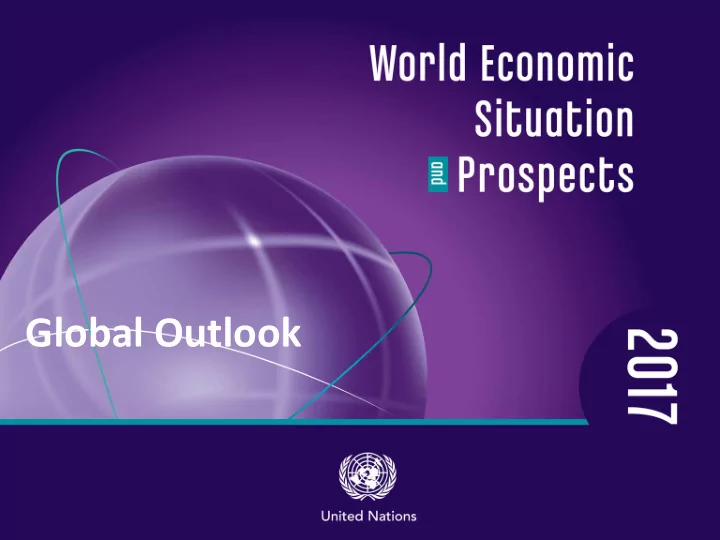

Global Outlook
Overview of global outlook Global economy remains trapped in prolonged episode of slow growth In 2016, world gross product and world trade expanded at slowest pace since Great Recession Modest recovery forecast for 2017/2018, but growth is not expected to approach pre-crisis average Return to strong and balanced growth unlikely without concerted policy efforts to stimulate investment and productivity 2
Global economy trapped… World gross product growth … in prolonged episode of slow growth 3
Prolonged slowdown… • Weak investment • Dwindling world trade growth • Flagging productivity growth • High debt levels Characterised by: • Conflict and geopolitical tensions • Low commodity prices since mid-2014 … may remain self -propagating 4
Policy challenges Raising finance for • Mobilizing domestic/international public investment: and private resources Healthcare, education, • May need additional concessional social protection, international public financing for LDCs climate change • More effective use of fiscal policy A more balanced policy • Macro policy fully integrated with structural approach reforms targeting e.g. poverty, inequality, climate change • Expedite clean technology transfer; raise Greater international climate finance; strengthen international policy coordination tax cooperation; address challenge of large movements of refugees and migrants 5
Regional Outlook East and South Asia
East and South Asia remains the fastest-growing region amid slow global growth Annual GDP growth rate (percentage) 10 8 6 4 2 0 2008 2009 2010 2011 2012 2013 2014 2015 2016 2017 2018 -2 -4 -6 -8 East and South Asia Developed economies Economies in transition Developing economies 7
Domestic demand continues to drive positive near-term outlook amid weak exports Percentage points 8 6 4 2 0 -2 2015 2016 2017 2015 2016 2017 2015 2016 2017 2015 2016 2017 2015 2016 2017 East Asia China Republic of Korea Indonesia Taiwan Province of China Private consumption Investment (including stockbuilding) Government consumption Net exports GDP growth 8
East Asia: Effective fiscal policy could play a more supportive role in enhancing growth • Policy rates across major economies in the region approached or reached historic low levels in 2016 – With few exceptions, central banks have some, but limited, room for further rate cuts – Domestic credit growth has not increased significantly despite loose monetary policy • Room for more active fiscal intervention exists, but effectiveness varies across the region – Overall fiscal balances worsened in 2015 across the region and are projected to worsen further, but public debt remains relatively low – Existing estimates in the literature suggest fiscal spending of the region’s smaller economies could be relatively less effective 9
South Asia: Growth expected to improve further Growth to benefit from robust consumption, a modest pick-up in investment and the implementation of domestic reforms Annual GDP growth rate (Percentage) 10 8 6 4 2 0 2012 2013 2014 2015 2016 2017 2018 -2 -4 South Asia India -6 Islamic Republic of Iran Afghanistan, Bhutan and Nepal (average) Bangladesh Pakistan 10
South Asia: Macroeconomic policies continue to support growth • Monetary policy remains accommodative – Potential further easing in some economies – Credit growth remains below trend in several countries • Fiscal policy stance continues to be moderately tight but with some degree of flexibility – Most Governments announced relatively tight fiscal stances, but tended to provide more support for their economies during implementation – Key medium-term fiscal challenges are to improve tax revenues and to promote a supportive environment for the private sector, which together can enhance the capacity to implement counter-cyclical policies 11
Downside risks and policy challenges for East and South Asia • Despite the region’s relative positive outlook, there are significant downside risks: – Potential renewed episodes of high financial volatility that could elevate rollover risk across region – Projected positive factors such as stronger external demand, higher commodity prices and rising infrastructure investment subject to considerable uncertainties – East Asia: high and rising corporate and household debt in some economies could exacerbate financial turbulences – South Asia: setbacks in the reform agenda and political instabilities could disturb investment prospects 12
Media contacts: Ken Matsueda, T: +1 (917)367 5418 | E: matsueda@un.org Sharon Birch, T: +1 (212)963 0564 | E: birchs@un.org http://www.un.org/en/development/desa/policy/wesp/
Recommend
More recommend